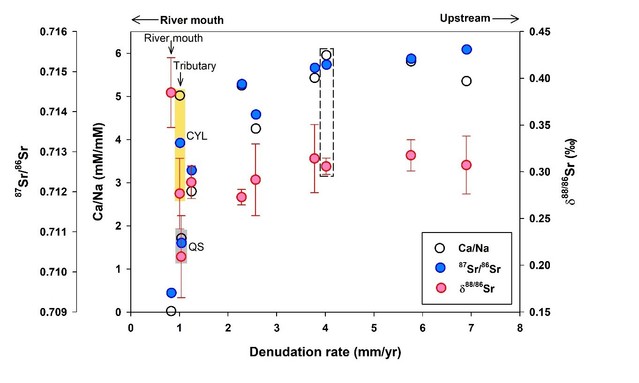Ni Sua, Shouye Yanga, Kai Denga, Yuan-Pin Changb, Juan Xua, Zhouyang Wua
a State Key Laboratory of Marine Geology, Tongji University, Shanghai 200092, China
b Institute of Marine Geology and Chemistry, National Sun Yat-sen University, Kaohsiung, Taiwan
Abstract
Small mountainous rivers (SMRs) in subtropical Taiwan supply a disproportionately large quantities of suspended and dissolved flux to the ocean due to extraordinarily high denudation rates in the world. We present major elements, 87Sr/86Sr, and Sr data of river water and sediment from two typical Taiwan SMRs, Zhuoshui (Choshui) and Liwu Rivers. High contents of dissolved Ca and Mg are generally accompanied by high 87Sr/86Sr ratios in waters of the Zhuoshui and Liwu Rivers (0.710721–0.715551 and 0.710461–0.711618). Sequential extraction experiments of river sediments reveal that Sr mainly resides in the residual silicate and acid-soluble fractions. High 87Sr/86Sr ratios of 0.709908–0.714168 in the acid-soluble fraction of the Zhuoshui River sediments indicate that disseminated calcite is present in silicate rocks. Rapid weathering of disseminated calcite in response to high denudation rate determines the high 87Sr/86Sr ratios in the upper Zhuoshui River water. Its downstream decreasing of 87Sr/86Sr ratios across major lithology could be explained by isotopic exchange between river water and sediment leaching fractions. However, all the 87Sr/86Sr ratios of the sequential leaching sediments from the Liwu River largely overlap along its course. The relatively low 87Sr/86Sr ratios of 0.708747–0.711070 in the acid-soluble fraction of the Liwu River sediments could be sourced from disseminated calcite and/or Tailuko marble, thus supplying low 87Sr/86Sr ratios to river waters.
Spatial variations in river water Sr values mainly occur between the mainstram and the tributary. The relation between Sr and 87Sr/86Sr in both rivers conservatively traces water-mass mixing, while the stable Sr isotope fractionation processes (e.g., biological uptake, clay reactions, and calcite precipitation) during transport in streams is negligible. Therefore, it is suggested that combining radiogenic and stable Sr isotopes in river water and/or sequential extracted sediment is an effective means to constrain chemical weathering as well as fractionation processes in a multi-lithological mountainous catchment with high denudation rate and wet climate.
Full Article:https://doi.org/10.1016/j.epsl.2021.117235


